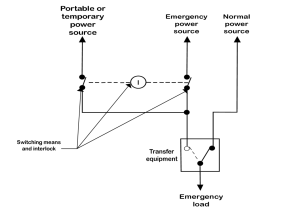How do 2023 NEC changes affect emergency power system synchronization?
Overview
Emergency power systems must have sufficient capacity and rating to meet the electrical demands of the building’s load during emergencies. Additionally, it is crucial that all power sources, including generators, seamlessly integrate with the main power grid through parallel operation. Improper synchronization can lead to significant issues, such as excessive current flow in unintended paths, resulting in injuries, damages, or even fatalities. The NEC 2023 edition revised Section 700.4 to specify rules for ensuring proper synchronization of all power sources, both normal and emergency, before they are operated in parallel. These updates enhance safety and reliability of buildings during emergency situations.
Improper synchronization can lead to significant issues, such as excessive current flow in unintended paths, resulting in injuries, damages, or even fatalities. The NEC 2023 edition revised Section 700.4 to specify rules for ensuring proper synchronization of all power sources, both normal and emergency, before they are operated in parallel. These updates enhance safety and reliability of buildings during emergency situations.
Applying the 2023 Code
Emergency power systems are essential for sustaining operations in critical facilities such as hospitals, data centers, and emergency response centers during power outages and disruptions on the main grid network. The capacity and rating of these systems are crucial in determining their ability to handle the electrical load of the facility during emergencies. However, these factors are influenced by various conditions within the facility’s power system, including loading, cable routing, fault ratings, and transient conditions. Therefore, it is imperative to accurately size and manage the emergency power system to ensure its effectiveness.
Furthermore, achieving seamless parallel operation or transition between the main grid and emergency power supply is crucial, requiring complete synchronism among all available power sources. Failure to synchronize systems properly regarding voltages, frequencies, or phases can lead to significant faults. Connecting unsynchronized systems poses severe risks of injury, damage, or even fatalities. In facilities with multiple emergency power sources, synchronization is essential between the backup and grid sources and among the different on-site sources. The NEC 2023 edition addressed this by revising Section 700.4(C) to include requirements for synchronizing emergency power sources with the main grid and with each other before connecting the systems in parallel operations. This addition promotes reliable and safe integration and parallel operation of emergency systems and main grid supplies, enhancing overall facility resilience and safety.
What’s New for the 2023 NEC?
The table below presents a comparison between the 2020 NEC and the 2023 NEC regarding Section 700.4.
2020 NEC |
2023 NEC |
| 700.4 Capacity and Rating
(A) Rating The emergency system equipment shall be suitable for the available fault current at its terminals. (B) Capacity An emergency system shall have adequate capacity in accordance with Article 220 or by another approved method. (C) Selective Load Pickup, Load Shedding, and Peak Load Shaving The alternate power source shall be permitted to supply emergency, legally required standby, and optional standby system loads where the source has adequate capacity or where automatic selective load pickup and load shedding is provided as needed to ensure adequate power to (1) the emergency circuits, (2) the legally required standby circuits, and (3) the optional standby circuits, in that order of priority. The alternate power source shall be permitted to be used for peak load shaving, provided these conditions are met. Peak load shaving operation shall be permitted for satisfying the test requirement of 700.3(B), provided all other conditions of 700.3 are met.
|
700.4 Capacity and Rating
(A) Capacity An emergency system shall have adequate capacity in accordance with Parts I through IV of Article 220 or by another approved method. The system capacity shall be sufficient for the rapid load changes and transient power and energy requirements associated with any expected loads. (B) Selective Load Management The alternate power source shall be permitted to supply emergency, legally required standby, and optional standby system loads where the source has adequate capacity or where load management (that includes automatic selective load pickup and load shedding) is provided as needed to ensure adequate power to the following in order of priority: (1) Emergency circuits (2) Legally required standby circuits (3) Optional standby circuits (C) Parallel Operation Parallel operation of the emergency source(s) shall consist of the sources specified in 700.4(C)(1) and (C)(2). (1) Normal Source The emergency source shall be permitted to operate in parallel with the normal source in compliance with Part I or Part II of Article 705 where the capacity required to supply the emergency load is maintained at all times. Any operating condition that results in less than the required emergency source capacity shall initiate a system malfunction signal in accordance with 700.6(A). Parallel operation shall be permitted for satisfying the test requirements of 700.3(B), provided all other conditions of 700.3 are met. Informational Note: Peak load shaving is one application for parallel source operation. (2) Emergency Source Emergency sources shall be permitted to operate in parallel where the necessary equipment to establish and maintain a synchronous condition is provided.
|
